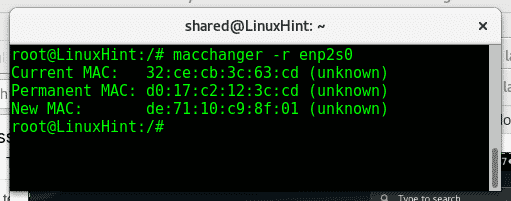

€œIt means that everything you send or receive is labeled with your real MAC address and therefore if you were to do something naughty, like download copyrighted material, they would know who you are much better than they do if all they have is an IP version 4 address,†Bowne said.Īnd for those for have been downloading files via what they thought as anonymous encrypted VPV services, need to know that there computer could have been leaking the users real IP address via the IPv6 protocol. The use of the so-called extended unique identifier means that people who want to remain anonymous online will have to take precautions that aren’t necessary under today’s IPv4 system.

What’s more, internet addresses that use the new protocol by default contain a 64-bit string that’s generated by a computer’s MAC, or Media Access Control, address.
Macchanger linux plus#
Plus the last article on using VPN services also shows how they may not be as anonymous as assumed.ĭefcon speaker calls IPv6 a ‘security nightmare’ The article below provides further insight and highlights how your MAC address could well become a unique virtual number plate, automatically identifying and recording everywhere one goes on the super highway. On those occasions that you do need to change a MAC address (for the right reasons) it's good to know you have a simple GUI tool in Linux to do the job. And, should you do so, Ghacks or the author is not, in any way, responsible for your actions. Do not attempt to use MACchanger-GTK for any purpose that would land you in trouble. I can't stress enough that this tool should only be used for legitimate, legal reasons. Once changed you can then click the Quit button to dismiss the MACchanger-Gtk window. That will change the MAC address of your network interface card. From the Options drop down select one of the methods for changing your address. If not, your best bet is to go with Random.Ĥ. If your NIC is detected with enough information you can then change the address to another address of the same manufacturer. Click See current MAC (this will display your address in a new window).ģ. Select your Network Interface from the drop down.Ģ. It offers various functions, such as changing the address so that it matches a specific manufacturer, or completely randomizing it. Once open you will see a very simple interface (see Figure 1) ready to change your MAC address. Macchanger (also known as the GNU MAC Changer) makes it easy to manipulate the MAC address for network interfaces. Instead you have to start it from either the command line (with the command macchanger-gtk) or by hitting F2 and then entering macchanger-gtk. But you will not find a menu entry for MACchanger-GTK.


 0 kommentar(er)
0 kommentar(er)
